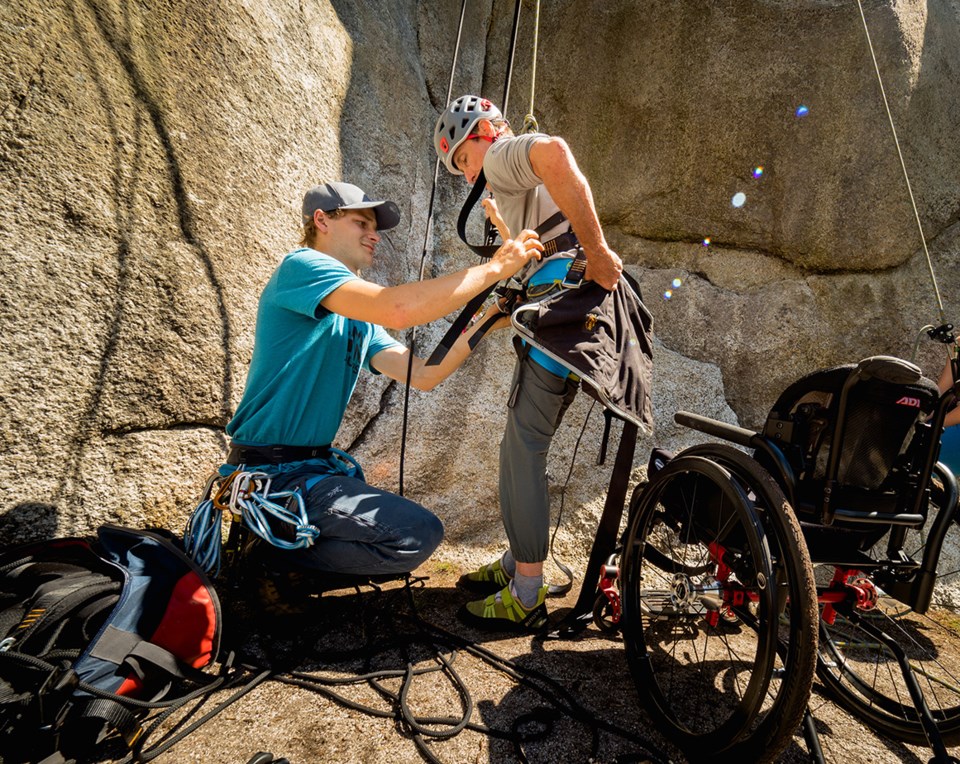The demand for climbing programs that assist people with disabilities is going up, particularly in the Sea to Sky Corridor.
The Canadian Adaptive Climbing Society’s outdoor climbing programs and indoor club nights were well-attended this summer and growth for the society is on the horizon.
Brent Goodman, director and founder of the Canadian Adaptive Climbing Society, says that, currently, some folks with disabilities who go to climbing gyms within the Sea to Sky Corridor and the Greater Vancouver area are being turned away. This is particularity worrisome to Goodman who believes that “climbing is really powerful and that the people who need it the most, don’t have access to it the way they should.”
Because of this, he started the Canadian Adaptive Climbing Society – also known as CACS – which seeks to provide and develop the best practices for inclusive climbing.
Currently CACS work is centred on offering three monthly club nights and summer outdoor climbing sessions. One of these club nights is hosted at Ground Up in Squamish, while the other two are offered in North Vancouver and Richmond.
These nights and outdoor sessions serve as an opportunity for participants with varying abilities to practice in rock climbing. Goodman says that while many participants and volunteers consistently attend events, some have never set foot in a climbing gym.
Occasionally, this has opened up the opportunity for Goodman to work privately with participants on bigger face climbs such as the Chief, or any of its smaller portions.
Goodman has began offering two-day discussion and first-hand experience-style training programs.
The purpose of these programs is to open up the conversation about who can climb – challenging preconceived notions about climbing as something for strictly able-bodied folks.
These programs give people the necessary information and techniques to create a more inclusive climbing gym. This summer, Goodman offered one of these training programs at Camp Good Time, located in Maple Ridge.
The first day was dedicated to teaching camp staff the techniques and etiquette necessary to offer disabled folks the opportunity to climb. The second day was a hands-on learning day where staff worked with climbers to practice freshly learned techniques.
Innovation is necessary to develop techniques that provide climbers the opportunity to climb – unique rope systems may be needed to aid climbers with cerebral palsy, spinal injuries and, in some cases, climbers with missing limbs.
Goodman stressed the importance of a holistic approach focusing on more than just the immediate physical obstacles climbers face – something Goodman cautions able-bodied people tend to exclusively focus on. He explained that it is important to recognize and meet the physical, social, emotional and mental needs of the climbers.
One technique Goodman has employed to achieve this goal is the counter balance system. This tool works by adding an additional individual to the traditional climbing and belayer duo. This additional person serves as a counter weight to the climber, meaning the climber does not have to support all of their own weight, making it easier to stay on the wall for longer, more safely.
The counter balance system does not just meet the physical needs of the climber.
Goodman believes that it gives participants like Georgina Hackett, who has cerebral palsy, the opportunity to climb.
Through climbing, Hackett has the opportunity to exercise control over her muscles, strengthening the neural pathways that cerebral palsy threatens.
Goodman believes that able-bodied climbers have a responsibility to make more of an inclusive climbing community.
“We need to be able to open up the doors of the climbing community to all cultures and abilities, not just upper-middle class white folk,” said Goodman.
He says that the key to creating a more inclusive climbing community is patience, collaboration, innovation and a change in perspective achieved through exposure.
Goodman says, that in the end, most of the society’s programs are designed to create the opportunity for exposure. He hopes that through exposure, climbing gyms approached by patrons with varied abilities will welcome them and say “yes lets figure something out, let’s go rock climbing.”



